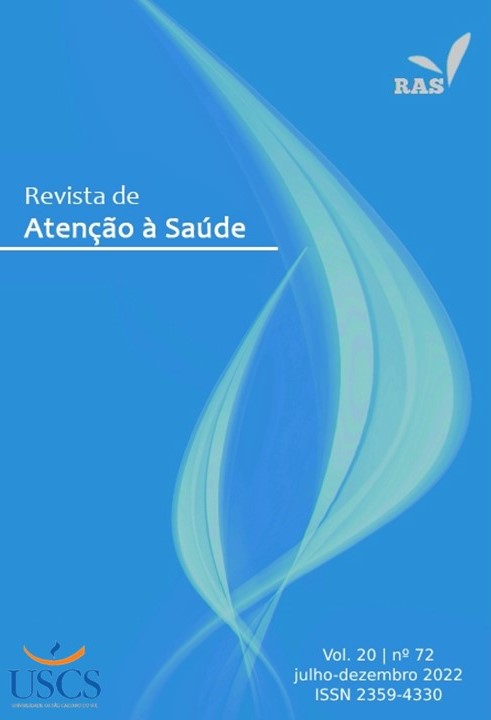“Woman is an animal that suffers”: a cross-cultural approach to experiences during childbirth
“Woman is an animal that suffers”: a cross-cultural approach
DOI:
https://doi.org/10.13037/2359-4330.8467Keywords:
Labor, Obstetric, Nursing, Anthropology, CulturalAbstract
Background: the experiences around parturition have heterogeneous meanings in different cultural contexts. Objective: to describe the cultural experiences of women about the obstetric care received during childbirth. Materials and methods: qualitative research, with a transcultural approach, conducted by ethnographic methodological reference, with 13 key informants in a public maternity hospital located in the state of Ceará, Brazil. The observation-participation-reflection enabler was adopted for data collection, recording observations in a field diary and individual interviews. The immersion process in the field took five months. The empirical material was submitted to the procedures of the ethno-nursing data analysis guide. Results: from the empirical reality expressed in the cultural scenario and from the informants' point of view, six cultural themes were apprehended that contemplated meanings attributed to motherhood, mode of delivery, diet, vaginal exams, companions and care received during parturition. Conclusions: the hostile institutional environment, proscribed obstetric practices and heteronomy in care were the core of the suffering of the parturients.
Downloads
References
Castro CM. Os sentidos do parto domiciliar planejado para mulheres do município de São Paulo, São Paulo. Cad. saúde colet. 2015;23(1):69-75. https://doi.org/10.1590/1414-462X201500010012
Pimenta LF, Ressel LB, Stumm KE. The cultural construction of the birth process. Rev. pesqui. cuid. fundam. 2013; 5(4):591-98. https://doi.org/10.9789/2175-5361.2013.v5i4.591-598
Nagahama EEI, Santiago SM. A institucionalização médica do parto no Brasil. Ciênc. saúde coletiva. 2005;10(3):651-57. https://doi.org/10.1590/S1413-81232005000300021
Matos GC, Escobal AP, Soares MC, Härter J, Gonzales RIC. The historic route of childbirth care policies in brazil: na integrative review. Rev. enferm. UFPE on line. 2013;7 (3):870-8. https://doi.org/10.5205/1981-8963-v7i3a11552p870-878-2013
Pereira ALF, Moura MAV. Relações de hegemonia e o conflito cultural de modelos na assistência ao parto. Rev. enferm. UERJ. 2008; 16(1):119-24.
Nakano AR, Bonan C, Teixeira LA. A normalização da cesárea como modo de nascer: cultura material do parto em maternidades privadas no Sudeste do Brasil. Physis (Rio J.). 2015;25(3):885-904. https://doi.org/10.1590/S0103-73312015000300011
Silva LR, Christoffel MM, Souza KV. História, conquistas e perspectivas no cuidado à mulher e à criança. Texto & contexto enferm. 2005;14(4):585-93. https://doi.org/10.1590/S0104-07072005000400016
Alves CN, Wilhelm LA, Barreto CN, Santos CC, Meincke SMK, Ressel LB. Cuidado pré-natal e cultura: uma interface na atuação da enfermagem. Esc. Anna Nery Rev. Enferm. 2015; 19(2):265-71. https://doi.org/10.5935/1414-8145.20150035
Cecagno S, Almeida FDO. Parto domiciliar assistido por parteiras em meados do século xx numa ótica cultural. Texto & contexto enferm. 2004;13(3):409-13. https://doi.org/10.1590/S0104-07072004000300010
Tesser CD, Knobel R, Andrezzo HFA, Diniz SD. Violência obstétrica e prevenção quaternária: o que é e o que fazer. Rev. bras. med. fam. comunidade. 2015;10(35):1-12. https://doi.org/10.5712/rbmfc10(35)1013
Nilvér H, Begley C, Berg M. Measuring women’s childbirth experiences: a systematic review for identification and analysis of validated instruments. BMC Pregnancy Childbirth. 2017; 17:203. https://doi.org/10.1186/s12884-017-1356-y
Belém JM, Pereira EV, Rebouças VCF, Borges JWP, Pinheiro AKB, Quirino GS. Theoretical, methodological and analytical aspects of ethnographic research in obstetric nursing: an integrative review. Rev. Esc. Enferm. USP. 2020; 54: e03547. https://doi.org/10.1590/S1980-220X2018034203547
Leininger M. Culture Care diversity and universality theory and evolution of the ethnonursing method. In: Leininger M, Mcfarland MR. Culture care diversity and universality: a worldwide nursing theory. 2ª ed. Boston (US): Jones and Bartlett Publishers; 2006. p. 01-42.
Bezerra MG, Cardoso MV. Fatores culturais que interferem nas experiências das mulheres durante o trabalho de parto e parto. Rev. latinoam. enferm. 2006; 14(3):414-21. https://doi.org/10.1590/S0104-11692006000300016
Ruano R, Prohaska C, Tavares Al, Zugaib M. Dor do parto - sofrimento ou necessidade? AMB rev. Assoc. Med. Bras. 2007; 53(5):377-88. https://doi.org/10.1590/S0104-42302007000500009
Pereira Rr, Franco Sc, Baldin N. A dor e o protagonismo da mulher na parturição. Rev. bras. anestesiol. 2011; 61(3):376-388. https://doi.org/10.1590/S0034-70942011000300014
Mccallum C, Reis A P. Re-significando a dor e superando a solidão: experiências do parto entre adolescentes de classes populares atendidas em uma maternidade pública de Salvador, Bahia, Brasil. Cad. saúde pública. 2006;22(7):1483-91. https://doi.org/10.1590/S0102-311X2006000700012
Almeida NAM, Medeiros M, Souza MR. Perspectivas de dor do parto normal de primigestas no período pré-natal. Texto & contexto enferm. 2012; 21(4):819-27. https://doi.org/10.1590/S0104-07072012000400012
Davim RMB, Torres GV, Dantas JC. Representação de parturientes acerca da dor de parto. Rev. eletrônica enferm. [Internet]. 2008;10(1):100-09. https://doi.org/10.5216/ree.v10i1.7685
Lagomarsino BS, Van Der Sand ICP, Girardon-Perlini NMO, Linck CL, Ressel LB. A cultura mediando preferências pelo tipo de parto: entrelaçamento de fios pessoais, familiares e sociais. REME rev. min. enferm. 2013;17(3):680-87. http://www.dx.doi.org/10.5935/1415-2762.20130050
Diniz CSG. Humanização da assistência ao parto no Brasil: os muitos sentidos de um movimento. Ciênc. saúde coletiva. 2005;10(3):627-637. https://doi.org/10.1590/S1413-81232005000300019
WHO. Care in normal birth: a practical guide. Technical Working Group, World Health Organization. Birth. 1997 [cited 2021 Apr 20];24(2):121-3. Available from: URL: http://apps.who.int/iris/bitstream/10665/63167/1/WHO_FRH_MSM_96.24.pdf
Hassan SJ, Sundby J, Husseini A, Bjertness E. The paradox of vaginal examination practice during normal childbirth: Palestinian women’s feelings, opinions, knowledge and experiences. Reprod. health. 2012; 9;1-9. https://doi.org/10.1186/1742-4755-9-16
Wei CY, Gualda DMR, Santos Junior HPO. Movimentação e dieta durante o trabalho de parto: a percepção de um grupo de puerpéras. Texto & contexto enferm. 2011;20(4):717-25. https://doi.org/10.1590/S0104-07072011000400010
Singata M, Tranmer J, Gyte GML.Restricting oral fluid and food intake during labour. Cochrane database syst. rev. 2013; 8:CD003930. https://doi.org/10.1002/14651858.CD003930.pub3
Brasil. Diretrizes nacionais de assistência ao parto normal. Secretaria de Ciência, Tecnologia e Insumos Estratégicos, Departamento de Gestão e Incorporação de Tecnologias em Saúde. – Brasília: Ministério da Saúde, 2017. 51 p. Available from: URL: http://bvsms.saude.gov.br/bvs/publicacoes/diretrizes_nacionais_assistencia_parto_normal.pdf
Leal MC, Pereira APE, Domingues RMSM, Theme Filha MM, Dias MAB, Nakamura-Pereira M, et al. Intervenções obstétricas durante o trabalho de parto e parto em mulheres brasileiras de risco habitual. Cad. saúde pública. 2014; 30:(1):17-47. https://doi.org/10.1590/0102-311X00151513
D’orsi E, Chor D, Giffin K, Angulo-Tuesta A, Barbosa GP, Gama AS, et al. Qualidade da atenção ao parto em maternidades do Rio de Janeiro. Rev. saúde pública. 2005;39(4):646-54. https://doi.org/10.1590/S0034-89102005000400020
Brown HC, Paranjothy S, Dowswell T, Thomas J. Package of care for active management in labour for reducing caesarean section rates in low-risk women. Cochrane Database Syst Rev. 2013;16(9):CD004907. https://doi.org/10.1002/14651858.CD004907.pub3
Clark SL, Simpson KR, Knox GE, Garite TJ. Ocitocina: novas perspectivas para uma droga antiga. Tempus – Actas de Saúde Coletiva. 2010; 4(4):161-72. https://doi.org/10.18569/tempus.v4i4.844
Sousa AMM, Souza KV, Rezende EM, Martins EF, Lansky DCS. Práticas na assistência ao parto em maternidades com inserção de enfermeiras obstétricas, em Belo Horizonte, Minas Gerais. Escola Anna Nery. 2016;20(2):324-331. https://doi.org/10.5935/1414-8145.20160044
Silva EC, Santos IMM. The perception of women concerning their parturition. R. pesq. cuid. fundam. online. 2009. 1(2):111-23. http://dx.doi.org/10.9789/2175-5361.2009.v1i2.%25p
Dixon L, Foureur M. The vaginal examination during labour: Is it of benefit or harm? New Zealand College of Midwives. 2010;42:21-26. Available from: URL: https://opus.lib.uts.edu.au/handle/10453/13828
Shepherd A, Cheyne H. The frequency and reasons for vaginal examinations in labour. Women and Birth. 2013;26(1):49-54. https://doi.org/10.1016/j.wombi.2012.02.001
Narchi NZ, Camargo JCS, Salim NR, Menezes MO, Bertolino MM. Utilização da “linha púrpura” como método clínico auxiliar para avaliação da fase ativa do trabalho de parto. Rev. bras. saúde matern. infant. 2011;11(3):313-22. https://doi.org/10.1590/S1519-38292011000300012
Downe S, Gyte GML, Dahlen HG, Singata M. Routine vaginal examinations for assessing progress of labour to improve outcomes for women and babies at term. Cochrane database syst. rev. 2013; (7): CD010088. https://doi.org/10.1002/14651858.cd010088.pub2
Wolff LR, Waldow VR. Violência Consentida: mulheres em trabalho de parto e parto. Saúde Soc. 2008;17(3):138-51. https://doi.org/10.1590/S0104-12902008000300014
Diniz CSG, Niy DY, Andrezzo HFA, Carvalho PCA, Salgado HO. A vagina-escola: seminário interdisciplinar sobre violência contra a mulher no ensino das profissões de saúde. Interface comun. saúde educ. 2016; 20(56):253-59. https://doi.org/10.1590/1807-57622015.0736
Bohren MA, Hofmeyr GJ, Sakala C, Fukuzawa RK, Cuthbert A. Apoio contínuo para mulheres durante o parto. Cochrane Database of Systematic Reviews. 2017;7:CD003766. https://doi.org/10.1002/14651858.CD003766.pub6
Souza SRRK, Gualda DMR. A experiência da mulher e de seu acompanhante no parto em uma maternidade pública. Texto & contexto enferm. 2016;25(1):e4080014. https://doi.org/10.1590/0104-0707201600004080014
Santos LM, Pereira SSC. Vivências de mulheres sobre a assistência recebida no processo parturitivo. Physis Revista de Saúde Coletiva. 2012; 22(1):77-97. https://doi.org/10.1590/S0103-73312012000100005
Diniz CSG, D’orsi E, Domingues RMSM, Torres JA, Dias MAB, Schneck CA, et al. Implementação da presença de acompanhantes durante a internação para o parto: dados da pesquisa nacional Nascer no Brasil. Cad. saúde pública. 2014;30(Suppl 1):140-53. https://doi.org/10.1590/0102-311X00127013
Nascimento NM, Progianti JM, Novoa RI, Oliveira TR, Vargens OMC. Tecnologias utilizadas por enfermeiras durante o parto. Esc. Anna Nery Rev. Enferm. 2010;14(3):456-61. https://doi.org/10.1590/S1414-81452010000300004
Giordani JN, Bisogno SBC, Silva LAA. Percepção dos enfermeiros frente às atividades gerenciais na assistência ao usuário. Acta paul. enferm. 2012;25(4):511-16. https://doi.org/10.1590/S0103-21002012000400005
Carvalho NAR, Monte BKS, Soares MC, Nery IS. Experiência de acadêmicos de enfermagem na promoção do parto humanizado. Revista Em Extensão. 2018; 16(2):253-263. https://doi.org/10.14393/REE_v16n22017_rel09
Narchi NZ, Diniz CSG, Azenha CAV, Scheneck CA. Women´s satisfaction with childbirth’ experience in different models of care: a descriptive study. Online braz. j. nurs. (Online). 2010; 9(2) Suppl 1. Available from: URL: http://www.objnursing.uff.br/index.php/nursing/article/view /j.1676-4285.2010.3102/692
Brüggemann OM, Ebsen ES, Oliveira ME, Gorayeb MK, Ebele RR. Motivos que levam os serviços de saúde a não permitirem acompanhante de parto: discursos de enfermeiros. Texto & contexto enferm. 2014;23(2):270-77. https://doi.org/10.1590/0104-07072014002860013
Belém JM, Pereira EV, Cruz RSBLC, Quirino GS. Divinization, pilgrimage, and social inequality: experiences of women in the access to obstetric assistance. Rev. Bras. Saude Mater. Infant. 2021;21(1):327-34. https://doi.org/10.1590/1806-93042021000100017
Downloads
Published
Issue
Section
License
Copyright (c) 2023 Jameson Moreira Belém, Emanuelly Vieira Pereira, Antonio Rodrigues Ferreira Júnior, Maria Rocineide Ferreira da Silva, Glauberto da Silva Quirino

This work is licensed under a Creative Commons Attribution-NonCommercial-NoDerivatives 4.0 International License.
Policy Proposal for Journals offering Free Delayed Access
Authors who publish in this magazine agree to the following terms:
- Authors maintain the copyright and grant the journal the right to the first publication, with the work simultaneously licensed under a Creative Commons Attribution License after publication, allowing the sharing of the work with recognition of the authorship of the work and initial publication in this journal.
- Authors are authorized to assume additional contracts separately, for non-exclusive distribution of the version of the work published in this magazine (eg, publishing in institutional repository or as a book chapter), with the acknowledgment of the authorship and initial publication in this journal.
- Authors are allowed and encouraged to publish and distribute their work online (eg in institutional repositories or on their personal page) at any point before or during the editorial process, as this can generate productive changes, as well as increase impact and citation of the published work (See The Effect of Open Access).









